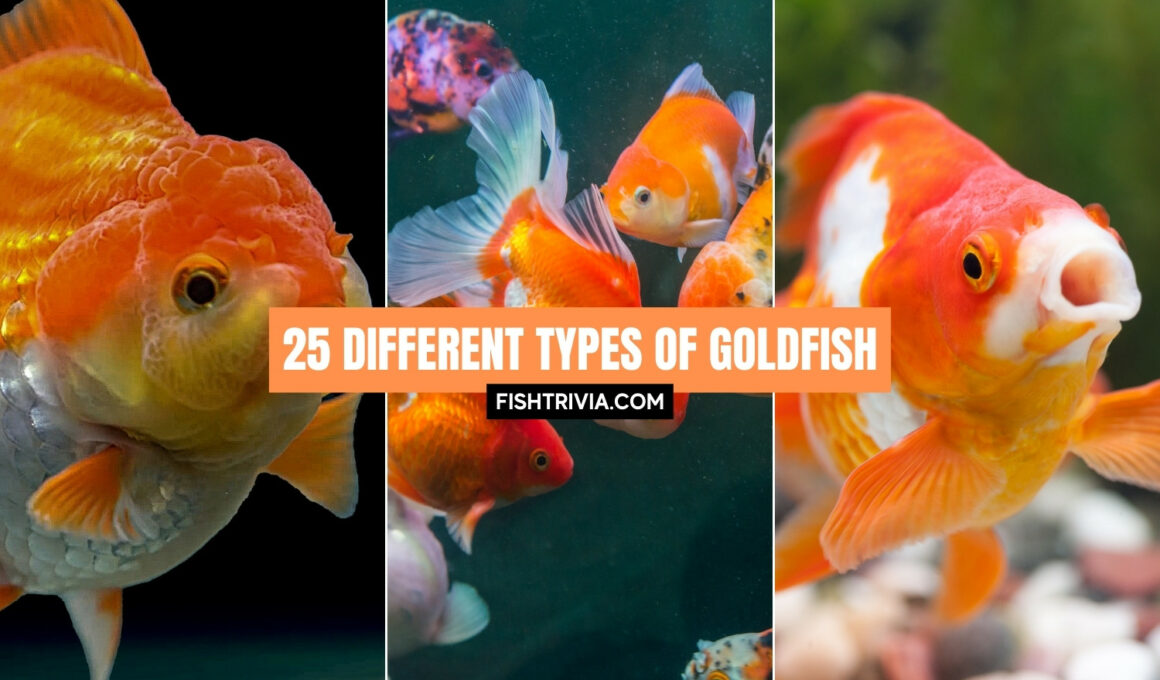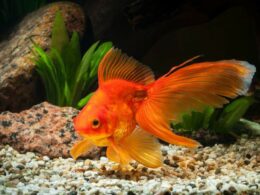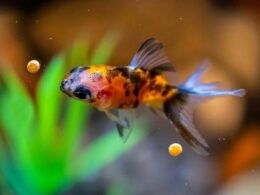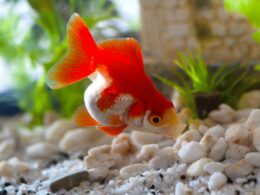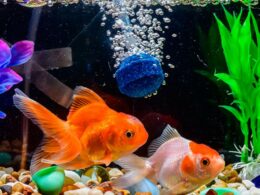In this article Show
Goldfish, known for their vibrant colors and diverse shapes, are more than just simple pets; they are a window into the art of aquatic care and the beauty of underwater life.
In this guide, we’ll cover everything you need to know about the various goldfish breeds. Each species has unique characteristics, care requirements, and history, from the common Goldfish to the exotic Izumo Nankin.
We aim to provide practical, easy-to-understand information that caters to both beginners and seasoned aquarium enthusiasts. Understanding different goldfish species is crucial for creating the optimal environment for your aquatic companions.
Proper care, nutrition, tank setup, and health management are key to ensuring your goldfish thrive. We’ll also touch on these species’ origins and historical significance, adding depth to your knowledge as a fish keeper.
Types Of Goldfish Explained
Whether you’re setting up your first tank or looking to add a new species to your collection, this guide is your go-to resource for all things goldfish species.
1. Common Goldfish
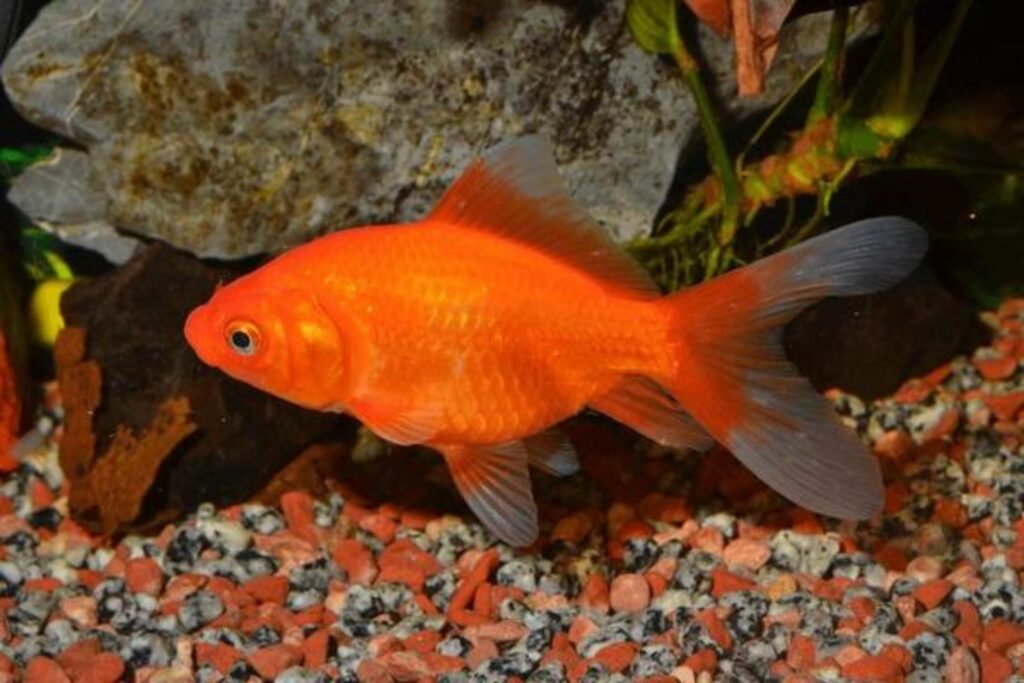
The Common Goldfish, a staple in the aquarium world, is believed to have originated from wild carp in ancient China. Over centuries, selective breeding transformed these fish into the vibrant and varied species we love today. Characterized by their bright orange hue and streamlined bodies, Common Goldfish symbolize luck and prosperity in many cultures.
Care Requirements
Caring for Common Goldfish is relatively straightforward, making them ideal for beginners. They require a balanced diet of high-quality goldfish flakes or pellets, supplemented with occasional treats like blanched vegetables or brine shrimp. Regular water changes and a consistent maintenance routine are vital to keep these fish healthy.
Ideal Tank Conditions
Despite their hardiness, Common Goldfish need spacious tanks to thrive, with at least 20 gallons for the first fish and an additional 10 gallons for each extra fish. They prefer cooler water temperatures, ranging from 65 to 72 degrees Fahrenheit, and a pH level between 7.0 and 7.4. Adequate filtration is essential to maintain water quality, as goldfish are known for being messy eaters.
2. Comet Goldfish
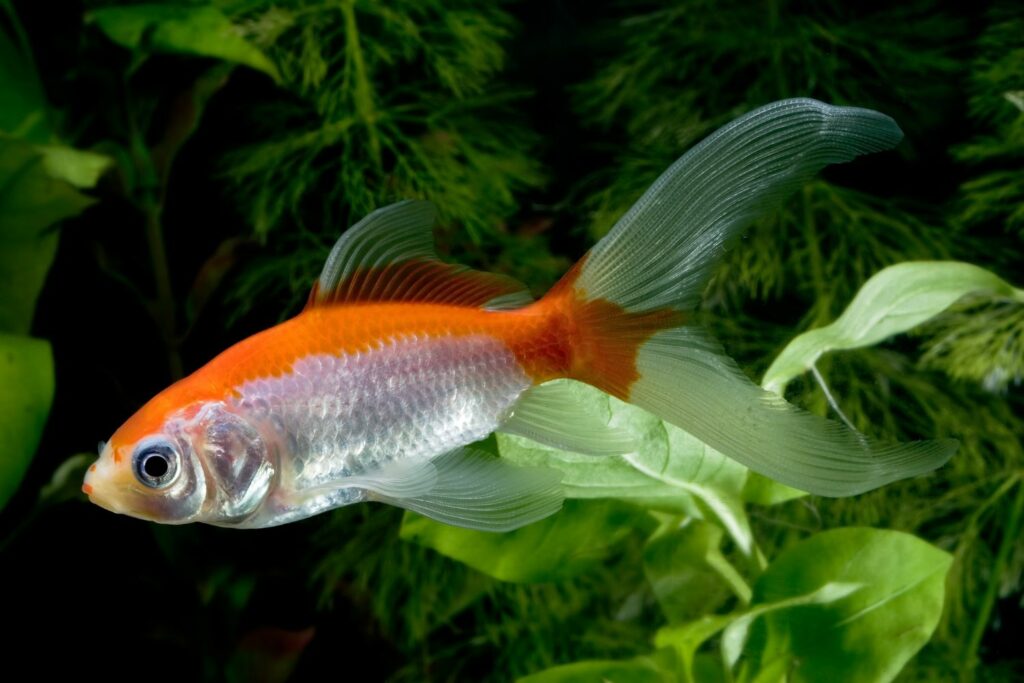
Comet Goldfish are distinguished by their long, flowing tails and sleek bodies. They come in a variety of colors, including orange, white, yellow, and red. Their most striking feature is their elongated, single-tail fin, which sets them apart from other goldfish varieties.
Diet and Nutrition
A balanced diet is crucial for Comet Goldfish. They thrive on a mix of goldfish pellets or flakes, alongside regular servings of fresh or frozen foods like daphnia, bloodworms, and veggies. Overfeeding should be avoided as it can lead to health issues and water quality problems.
Compatibility with Other Fish
Comet Goldfish are peaceful and social, making them compatible with other non-aggressive fish. However, their high activity levels and feeding habits can be overwhelming for slower-moving fish. Tankmates should be chosen carefully to ensure a harmonious aquarium.
3. Shubunkin Goldfish
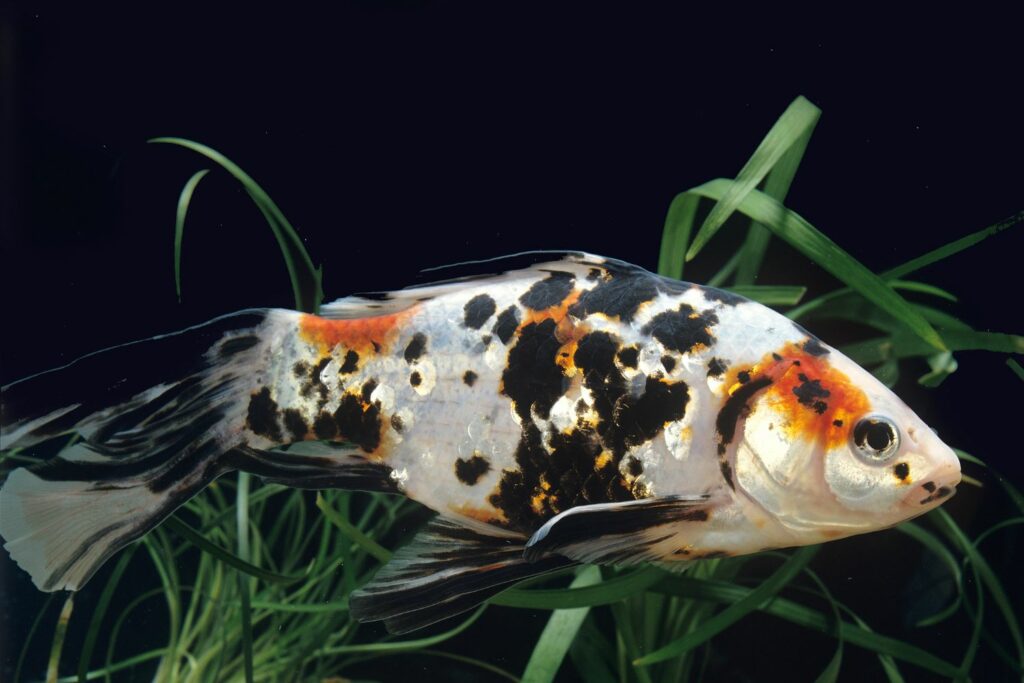
Shubunkin Goldfish, with their calico patterns, originated in Japan in the early 20th century. They are a crossbreed, combining traits of the Common Goldfish with other fancy varieties. Their name translates to “chrysanthemum goldfish,” reflecting their multicolored, petal-like patterns.
Unique Features
Their most distinct feature is their vibrant, speckled coloration, which includes a mix of blue, orange, black, and white. They also have a slender, streamlined body and a long, flowing tail, making them a visually striking addition to any tank.
Breeding Habits
Breeding Shubunkin Goldfish requires a spacious tank or pond, as they are prolific breeders. Springtime, with its warmer temperatures, typically triggers their breeding season. Providing a suitable environment with ample vegetation and a nutritious diet can encourage successful breeding.
4. Fantail Goldfish
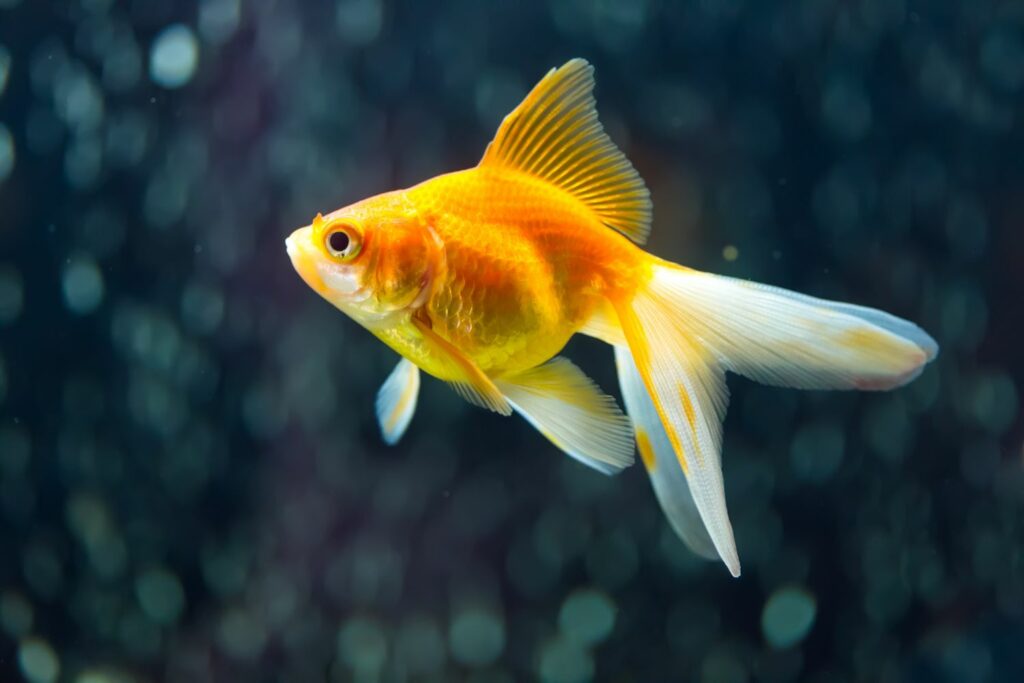
Fantail Goldfish are admired for their rounded, fan-shaped tails and elegant swimming style. They boast a wide variety of colors, ranging from solid orange to multi-colored patterns including white, black, and red. Their distinctive feature is their split tail fin, which is proportional to their body size and gracefully fans out as they swim.
Tank Size and Water Parameters
Fantail Goldfish require spacious tanks to accommodate their flowing fins and active swimming. A minimum of 20-30 gallons is recommended for one Fantail, with an additional 10-20 gallons per additional fish. They thrive in water temperatures between 65 and 75 degrees Fahrenheit and a pH level from 6.5 to 7.5. Good filtration is essential to keep the water clean and oxygen-rich.
Common Health Issues
Like all goldfish, Fantails are prone to swim bladder disorders, which affect their buoyancy and swimming ability. They can also suffer from fin rot and fungal infections, often due to poor water quality. Regular water changes and a well-maintained tank are crucial for preventing these health issues.
5. Oranda Goldfish
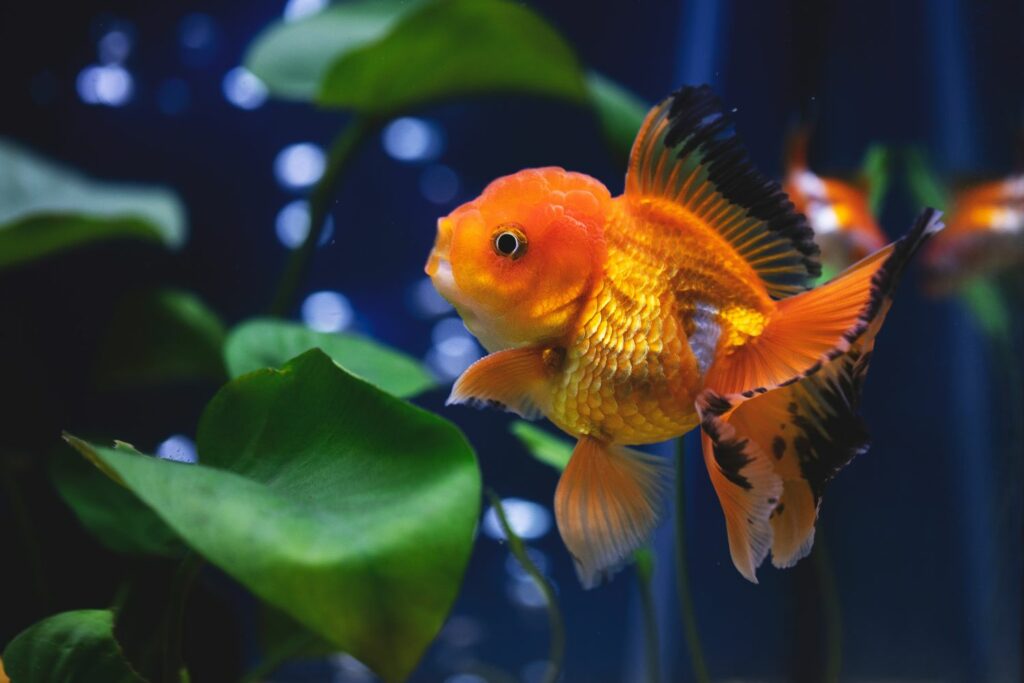
Oranda Goldfish are easily recognizable by their “wen” – a unique, cap-like growth on their head. This wen continues to grow throughout their life. They have a rounded, egg-shaped body and come in various colors, including red, black, blue, chocolate, and tricolor.
Feeding and Diet Specifics
Orandas have a hearty appetite and require a balanced diet of high-quality goldfish pellets or flakes, supplemented with vegetables and occasional protein treats like brine shrimp. Overfeeding can lead to obesity and health issues, so portion control is important.
Social Behavior
Oranda Goldfish are social and gentle, making them great companions for other non-aggressive goldfish. They are not as swift as other species, so they should be paired with fish that won’t outcompete them for food. Their social nature means they thrive in a community setting, but care should be taken to avoid tankmates that might nip at their delicate wens.
6. Ryukin Goldfish
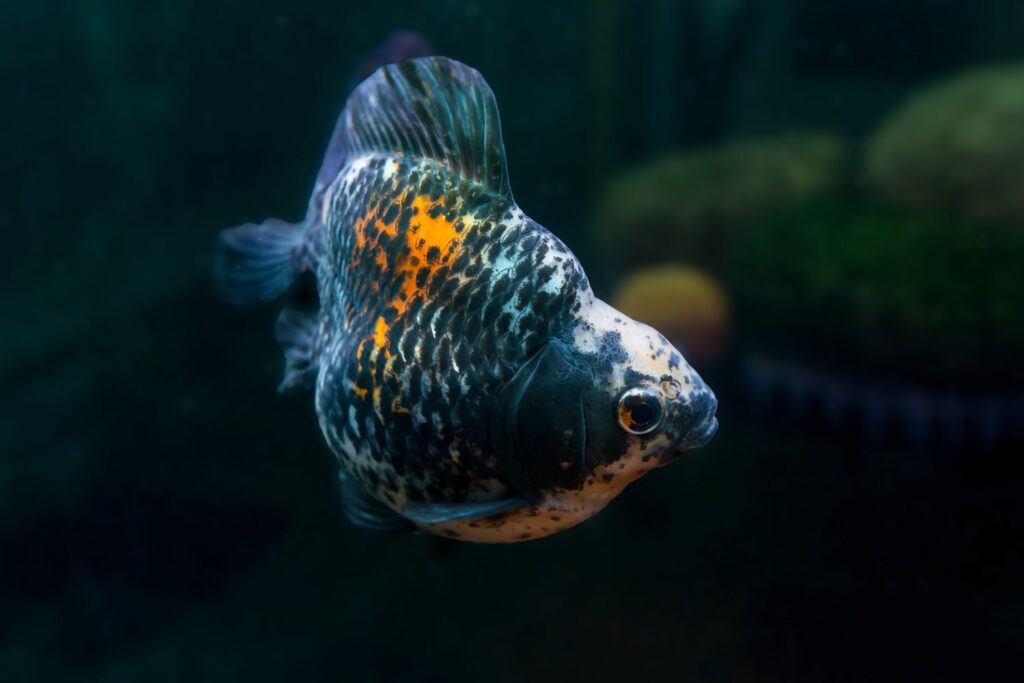
Ryukin Goldfish are distinguished by their deep, humpbacked body shape and high, arched dorsal fin. Their finnage is elaborate, with a flowing tail that can be either long or short, depending on the variety. Ryukins are available in several colors, including red, calico, white, and red-and-white combinations.
Environmental Needs
Ryukins require a larger tank to accommodate their size and active swimming habits – at least 30 gallons for a single fish. Water temperatures should be maintained between 65 and 78 degrees Fahrenheit, with a pH between 6.8 and 7.5. They are sensitive to poor water conditions, so regular water testing and maintenance are crucial.
Lifespan and Growth
With proper care, Ryukin Goldfish can live up to 10-15 years. They grow relatively quickly, reaching maturity in a few years. Consistent care, good nutrition, and a suitable living environment are key factors in ensuring these beautiful goldfish’s long and healthy life.
7. Black Moor Goldfish
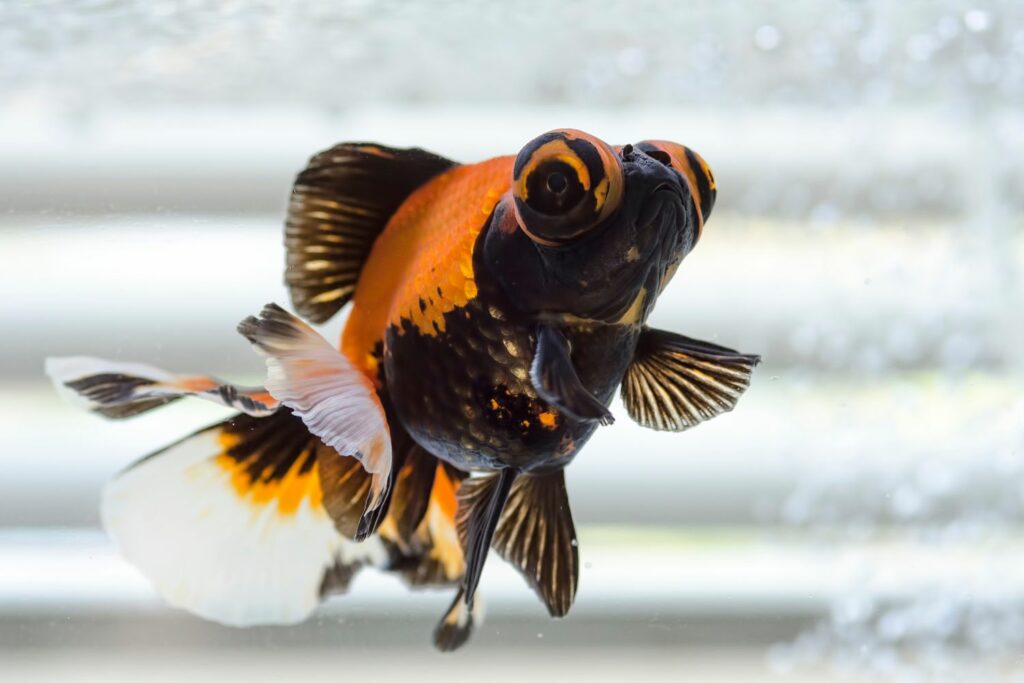
Black Moor Goldfish are known for their large, telescopic eyes and velvety black bodies. Their eyes protrude significantly from the sides of their heads, giving them a distinctive appearance. However, this unique feature also limits their field of vision, making them slower to locate food and navigate around the tank.
Tank Mates and Social Interaction
Due to their impaired vision, Black Moors are best paired with other goldfish that have similar swimming speeds and styles, such as Fantails or Ryukins. Fast swimmers or nippy fish should be avoided as tank mates. Black Moors are social and peaceful, enjoying the company of their kind and other gentle goldfish breeds.
Maintenance and Care
Black Moors need a spacious and well-maintained tank with minimal obstacles to prevent injuries to their eyes. They thrive in temperatures between 65 and 75 degrees Fahrenheit and a pH level of 6.5 to 7.5. Regular water changes and a good filtration system are essential to maintain water quality, as poor conditions can lead to health issues.
8. Bubble Eye Goldfish
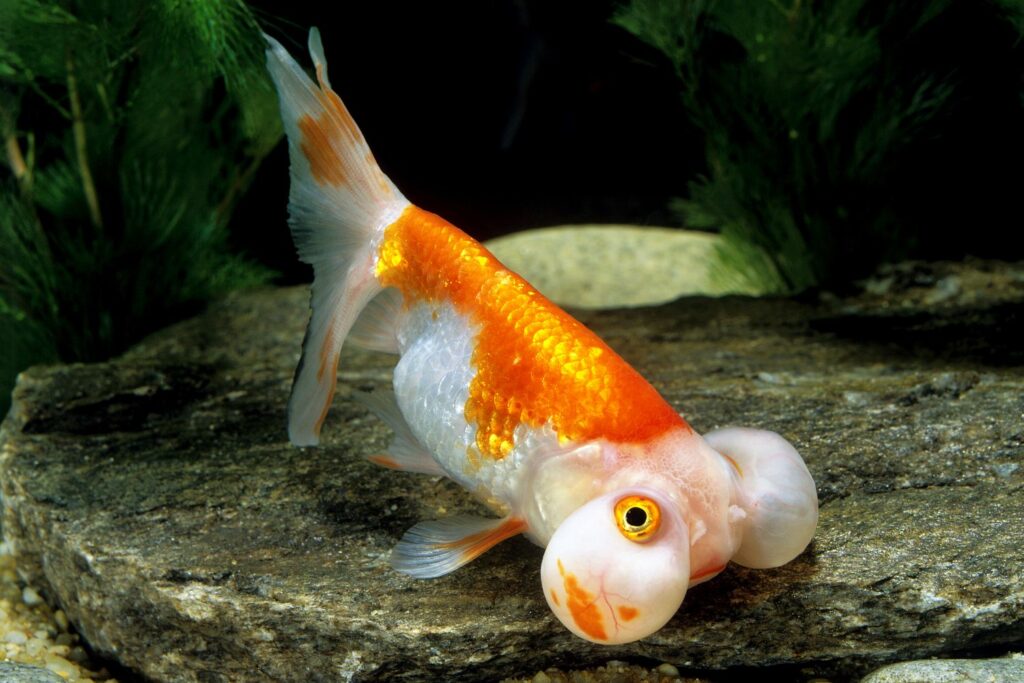
Bubble Eye Goldfish are most notable for the two large fluid-filled sacs under their eyes, which give them a unique and delicate appearance. These sacs start developing when they are a few months old and can become quite large. Their bodies are rounded, and they lack a dorsal fin, adding to their distinctive look.
Special Care Considerations
The bubble eyes of these goldfish are very fragile and can burst if they come into contact with sharp tank decorations or aggressive tank mates. They require a tank setup with smooth, soft decorations and no sharp edges. Additionally, gentle filtration is necessary to prevent damage to their eye sacs.
Breeding Challenges
Breeding Bubble Eye Goldfish can be challenging due to their delicate nature. The bubble sacs make them less agile and more vulnerable during spawning. Breeders must provide a safe, controlled environment with plenty of vegetation for egg laying while ensuring the parents do not injure themselves.
9. Telescope Goldfish
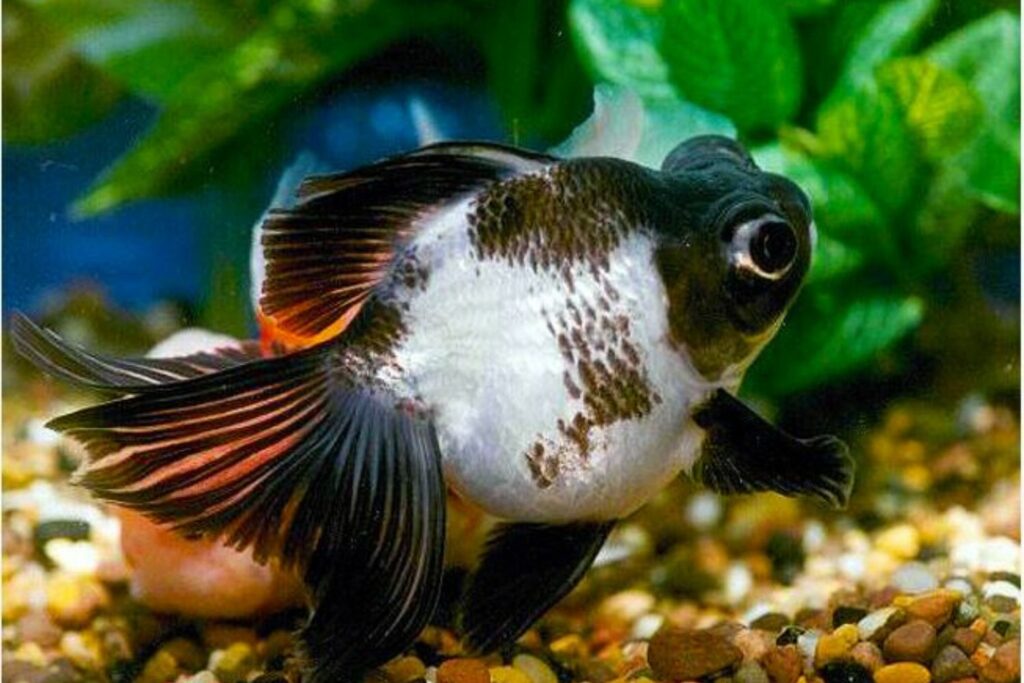
Telescope Goldfish, also known as Demekin, are characterized by their large, protruding eyes which resemble telescopes. These eyes can be quite striking, but like other fancy goldfish, they limit the fish’s vision and make them more prone to accidents.
Suitable Aquarium Setup
A tank for Telescope Goldfish should be spacious and free of sharp or hazardous objects. They do best in tanks of at least 20-30 gallons, with a temperature range of 65 to 75 degrees Fahrenheit and a pH level between 6.5 and 7.5. Soft, rounded decorations and plants are recommended to prevent injury to their eyes.
Health Concerns
Due to their eye structure, Telescope Goldfish are susceptible to eye injuries and infections. They also may struggle to compete for food with faster-moving fish. Maintaining clean, well-filtered water and a stress-free environment is crucial for their well-being. Regular health checks are recommended to catch any issues early.
10. Lionhead Goldfish
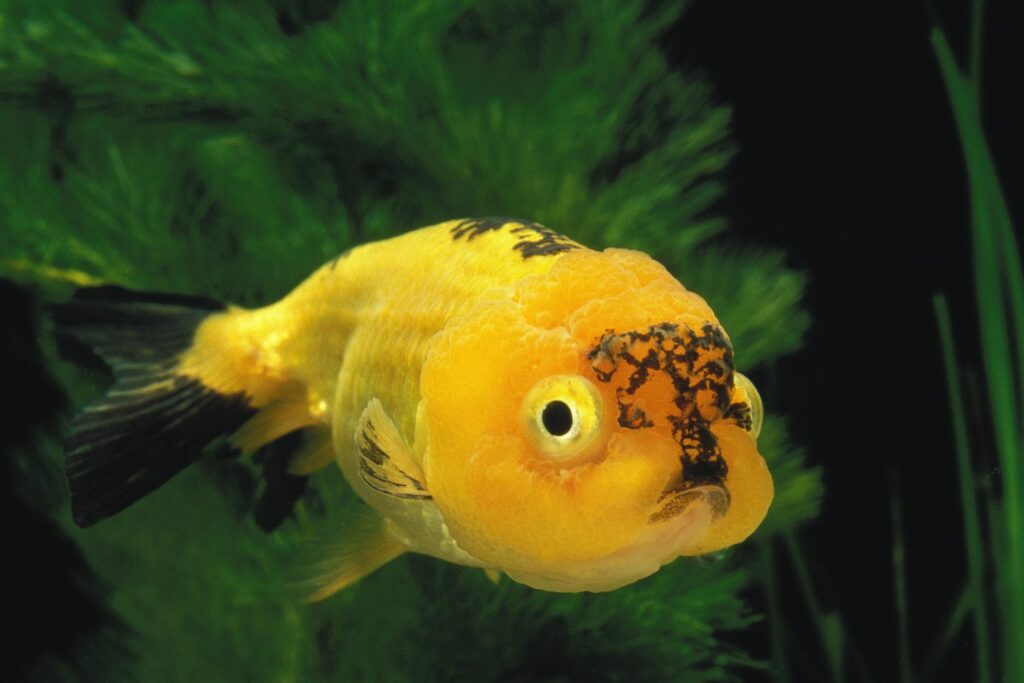
Lionhead Goldfish are renowned for their ‘wen,’ a fleshy growth on top of their head that resembles a lion’s mane. This hood starts developing when they are a few months old and continues to grow throughout their lives. It can cover their entire head and gill covers, giving them a unique and distinguished appearance.
Dietary Requirements
Lionhead Goldfish need a balanced diet rich in vitamins and minerals to support healthy wen growth. They thrive on high-quality goldfish pellets or flakes, supplemented with vegetables like peas and spinach, and occasional protein sources such as brine shrimp or bloodworms. It’s important to feed them in small amounts multiple times a day to avoid overfeeding.
Behavior and Temperament
Lionhead Goldfish are generally peaceful and sociable, making them suitable for community tanks with other non-aggressive goldfish. Due to their slower swimming pace and delicate wen, they should not be kept with fast swimmers or fin-nipping species. They are interactive and can become quite personable with their owners.
11. Lionhead Goldfish
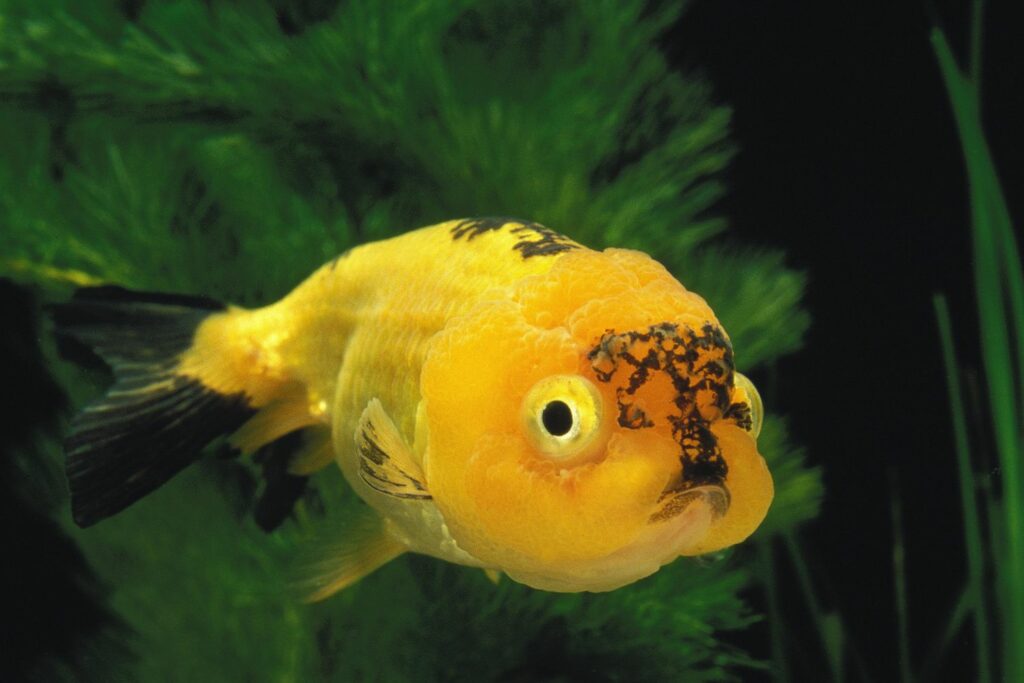
Ranchu Goldfish are often compared to Lionheads due to their similar wen growth. The key difference lies in their back profile; Ranchus have a more arched back and a shorter tail fin, giving them a more rounded appearance. Their wen also tends to be more developed and rounded, covering more of the head.
Ideal Living Conditions
Ranchus requires a spacious tank with a minimum of 20 gallons to allow for comfortable swimming. They prefer slightly warmer water, with temperatures between 68 and 74 degrees Fahrenheit, and a pH level of 6.5 to 7.5. Soft, smooth decorations and substrates are recommended to prevent injury to their delicate bodies and wens.
Breeding Tips
Breeding Ranchu Goldfish requires a dedicated approach due to their delicate nature. A separate breeding tank with ample vegetation for egg-laying is ideal. During the breeding season, increase the feeding frequency and provide high-quality, nutrient-rich foods to encourage spawning. Gentle filtration is necessary to protect both the eggs and the adult fish.
12. Pearlscale Goldfish
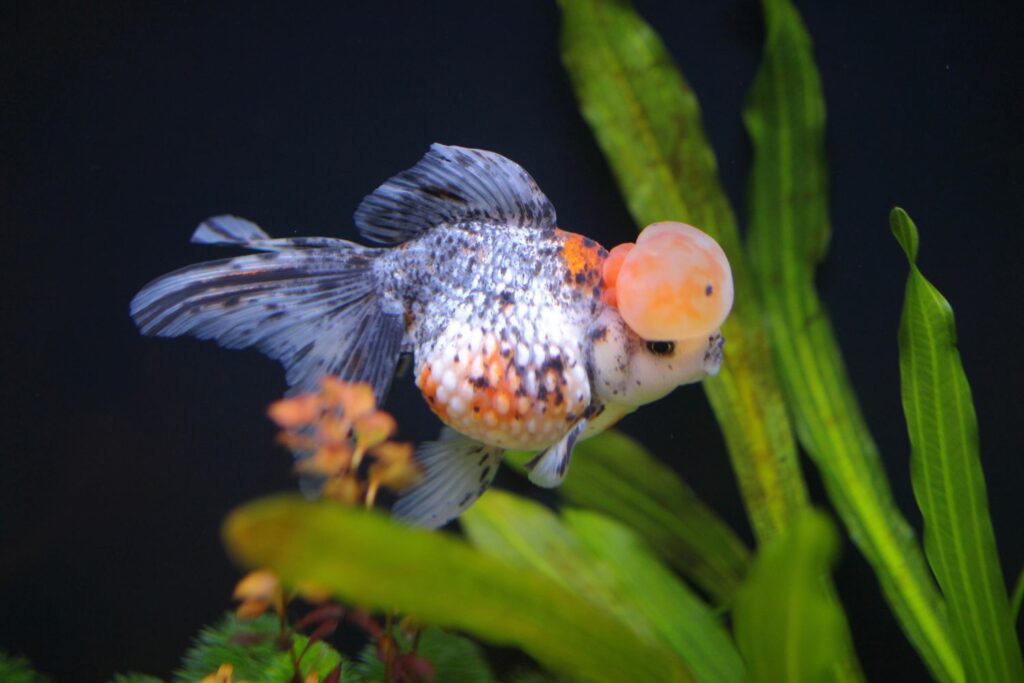
Pearlscale Goldfish are notable for their unique, pearl-like scales, which give them a distinctive, bubbly appearance. Each scale has a raised center, resembling a bead or pearl, covering their round, plump bodies. This feature makes them one of the most visually striking goldfish varieties.
Nutrition and Feeding
A balanced diet is crucial for maintaining the health and luster of Pearlscale Goldfish. They should be fed a variety of foods, including high-quality pellets or flakes, leafy greens, and occasional protein treats like brine shrimp. Overfeeding should be avoided as it can lead to digestive issues and affect their buoyancy.
Water Quality Importance
The health and growth of Pearlscale Goldfish are heavily influenced by water quality. They require clean, well-oxygenated water with a 65 to 75 degrees Fahrenheit temperature range and a pH level between 6.5 and 7.5. Regular water changes and efficient filtration are essential to keep their environment free from toxins and waste, ensuring their distinctive scales remain healthy and vibrant.
13. Celestial Eye Goldfish
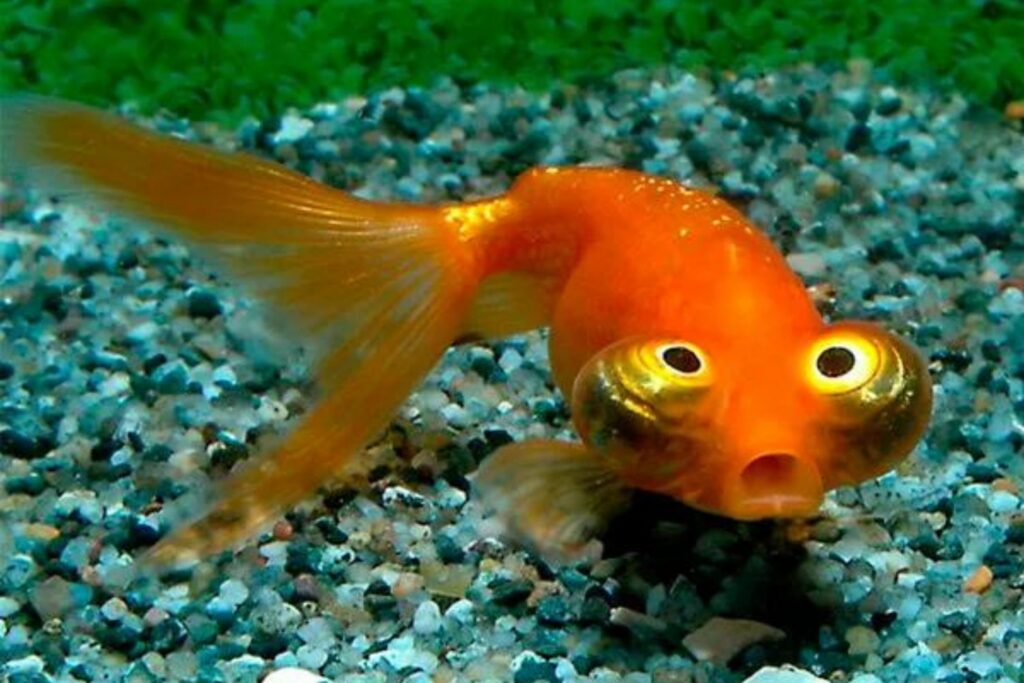
Celestial Eye Goldfish are known for their unique upward-facing eyes, which give them a distinctive and endearing appearance. This feature, however, makes them less aware of their surroundings and more prone to accidents. Their eyes are delicate, requiring an aquarium setup free from sharp objects and rough decorations to prevent injuries.
Aquarium Environment
A tranquil and safe environment is crucial for Celestial Eye Goldfish. They thrive in tanks that are at least 20 gallons, with a temperature range between 65 to 75 degrees Fahrenheit and a pH level of 6.5 to 7.5. Soft, fine substrates and smooth-edged decorations are recommended. Strong currents should be avoided as they can cause stress and difficulty in swimming.
Interaction with Other Species
Due to their limited vision and calm nature, Celestial Eye Goldfish are best housed with other peaceful and slow-moving goldfish varieties. They may struggle to compete for food with faster or more aggressive fish, so careful selection of tank mates is important to ensure harmonious coexistence.
14. Veiltail Goldfish
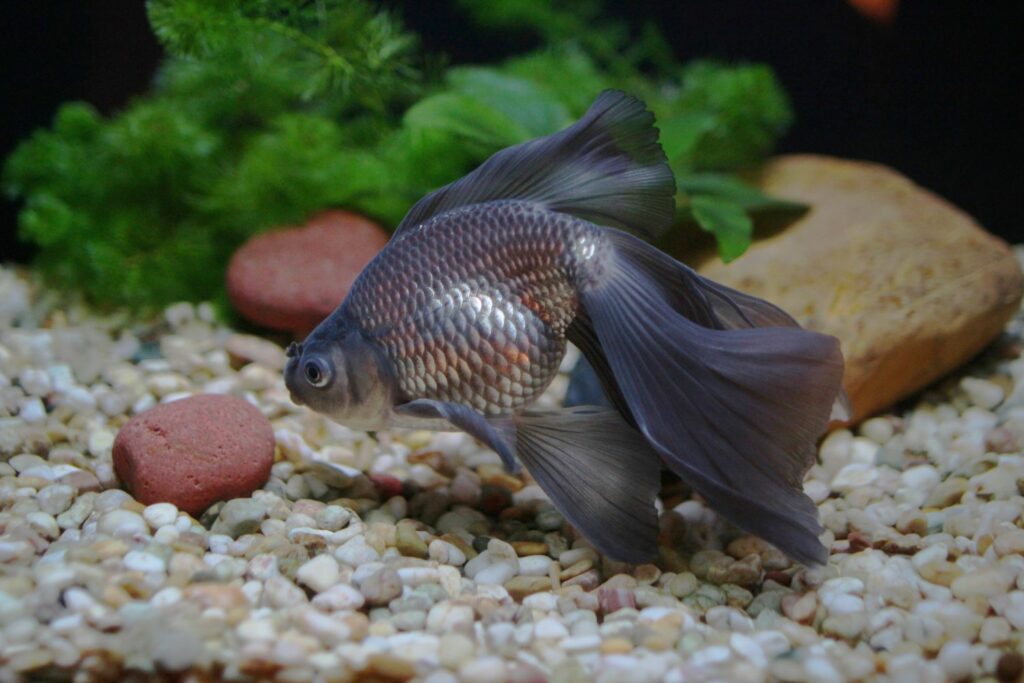
Veiltail Goldfish are admired for their long, flowing tail fins and elegant, slow-moving swimming style. Their tails are delicate and require spacious tanks to allow them to swim freely without damaging their fins. The ideal tank should have minimal obstacles and decorations to prevent fin tearing.
Common Diseases
Veiltail Goldfish are susceptible to common goldfish ailments like fin rot and swim bladder disease. Poor water quality and overcrowding can lead to these issues. Maintaining clean water, a balanced diet, and a stress-free environment are key to keeping them healthy.
Breeding Environment
Breeding Veiltail Goldfish requires a specific setup to ensure the safety and health of both the adults and the fry. A separate breeding tank with ample space, gentle filtration, and vegetation for egg-laying is ideal. Water quality and temperature should be carefully monitored to create optimal breeding conditions.
15. Tosakin Goldfish
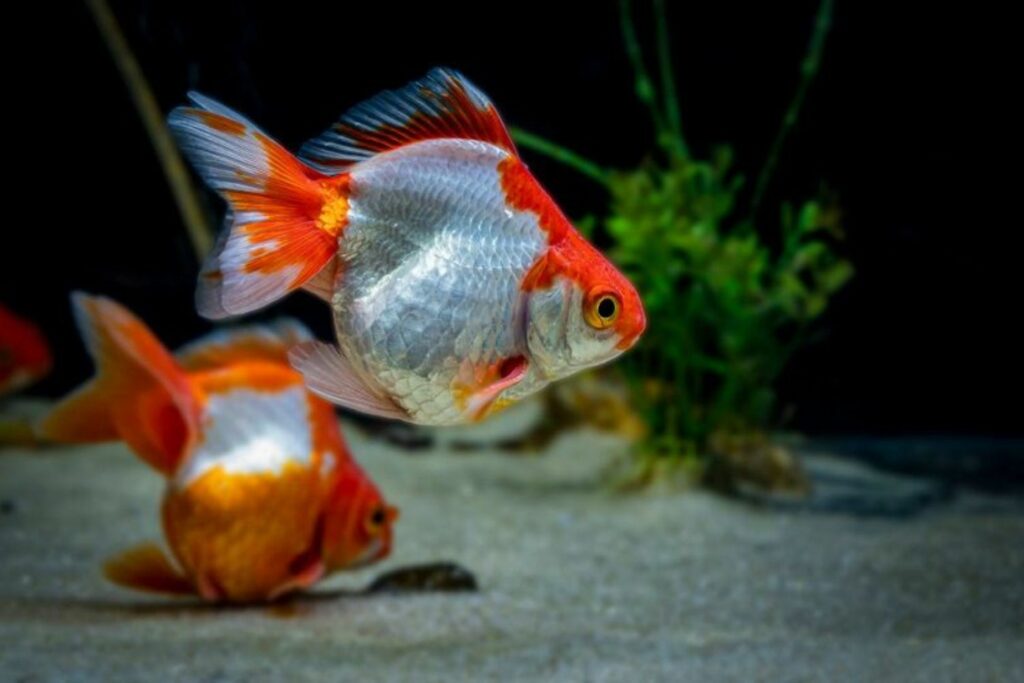
Tosakin Goldfish are unique for their distinct tail shape, which fans out horizontally like a peacock’s tail when viewed from above. This feature, along with their rounded body shape, influences their swimming style, making them less agile than other goldfish varieties.
Special Care Needs
Due to their unique tail and body structure, Tosakin Goldfish require special care. They need a spacious tank with plenty of room to swim and a gentle water current to prevent stress. The tank should be free from sharp decorations and have a soft substrate to protect their delicate fins and bodies.
Historical Significance
Originating from Japan, Tosakin Goldfish have a rich history and are considered a prized variety among goldfish enthusiasts. They were developed in the 19th century and are known for their beauty and rarity. Preserving their lineage and unique characteristics is of great importance to goldfish breeders and collectors worldwide.
16. Pompon Goldfish
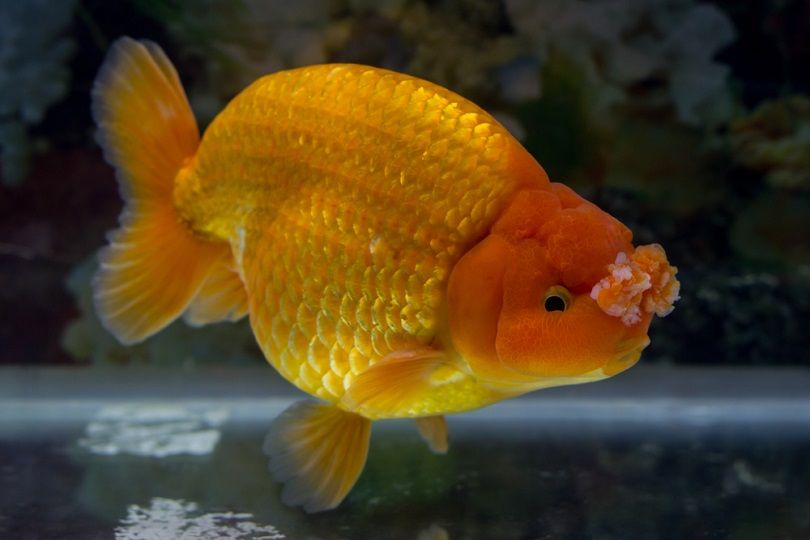
Pompon Goldfish are distinguished by their unique nasal growths, known as pompoms, which are fleshy lobes located near their nostrils. These lobes can be quite pronounced and give the fish a distinctive, ornamental look. They typically have a round body shape and can come in various colors, including orange, white, and red.
Tank Setup and Parameters
For Pompon Goldfish, a well-maintained tank is crucial to prevent damage to their delicate pompoms. A minimum of 20 gallons is recommended for a single fish, with an additional 10 gallons for each extra fish. They prefer water temperatures between 65 to 75 degrees Fahrenheit and a pH level of 6.5 to 7.5. Smooth decorations and substrates are advised to avoid injury to their nasal growths.
Compatibility Issues
Due to their unique pompoms and generally peaceful nature, Pompon Goldfish are best kept with other gentle and slow-moving goldfish species. They may be outcompeted for food by faster fish and can be prone to bullying by more aggressive species. Selecting compatible tank mates is essential for their well-being.
17. Wakin Goldfish
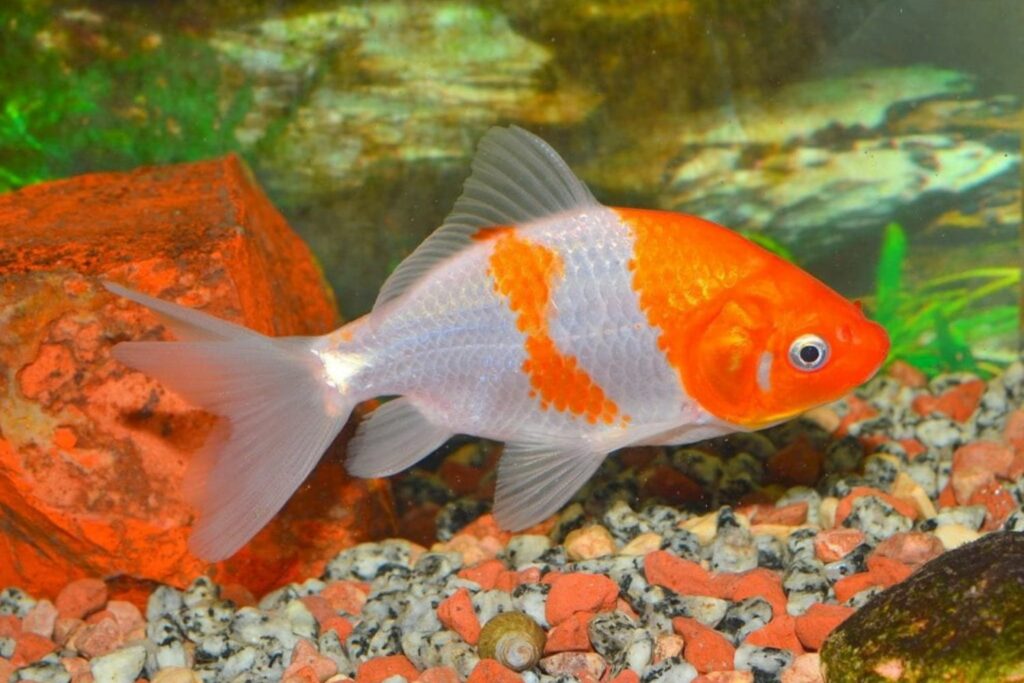
Wakin Goldfish are known for their vibrant colors and a split tail fin that is less pronounced than that of fancy goldfish breeds. They have a streamlined body shape similar to Common Goldfish, which makes them strong and agile swimmers. Their coloration often includes a mix of red and white.
Outdoor Pond Suitability
Wakin Goldfish are an excellent choice for outdoor ponds due to their hardiness and adaptability. They can thrive in a wide range of temperatures, making them suitable for various climates. A pond environment allows them more space to swim and exhibit natural behaviors.
Diet Preferences
Wakins are omnivorous and have a hearty appetite. Their diet should include high-quality goldfish pellets or flakes, supplemented with fresh vegetables and occasional protein sources like worms or small crustaceans. In pond settings, they also enjoy grazing on natural algae and small insects.
18. Jikin Goldfish
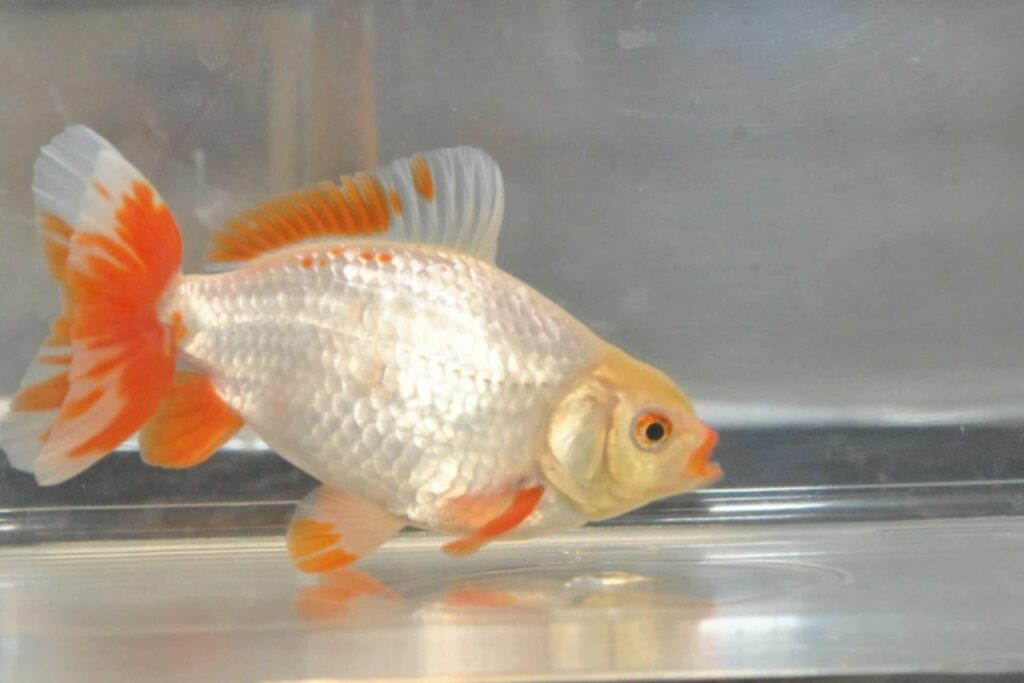
Jikin Goldfish are admired for their distinct coloration, typically featuring a red and white pattern. They are characterized by their “peacock tail” finnage, where the tail splits into several lobes. The ideal Jikin has a symmetrical color pattern, with red only on the lips, fins, and gill covers.
Water Conditions and Temperature
Jikin Goldfish require a clean and stable environment. They do best in water temperatures ranging from 65 to 75 degrees Fahrenheit and a pH level between 6.5 and 7.5. Regular water changes and efficient filtration are necessary to maintain optimal water quality.
Social Interaction
Jikins are peaceful and can be kept with other non-aggressive goldfish breeds. However, their unique fin structure makes them less agile, so they should not be housed with overly active or fin-nipping species. They enjoy social interactions with both their human caregivers and tank mates, making them a delightful addition to a community tank.
19. Moor Goldfish
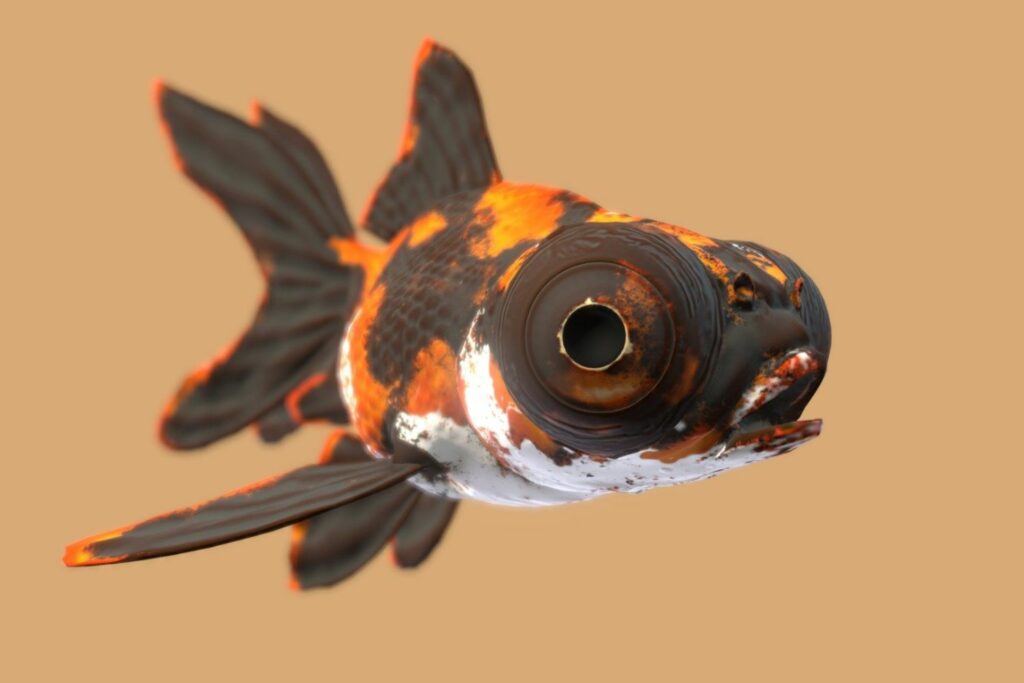
Moor Goldfish, also known as Black Moors, are known for their velvety black color that covers their entire body and fins. This deep, uniform black is a striking feature. They have a rounded body and large, telescopic eyes, with flowing fins that add to their elegant appearance.
Vision-Related Care
Due to their protruding eyes, Moor Goldfish have limited vision, making them more prone to accidents. Their tank should be free of sharp or abrasive decorations to prevent eye injuries. Gentle filtration is recommended to avoid strong currents that can stress them.
Suitable Tank Mates
Moor Goldfish are peaceful and do well with other goldfish that have a similar swimming ability and temperament. Suitable tank mates include other fancy goldfish like Ryukins or Orandas. Fast swimmers or aggressive fish should be avoided to ensure a harmonious tank environment.
20. Tamasaba Goldfish
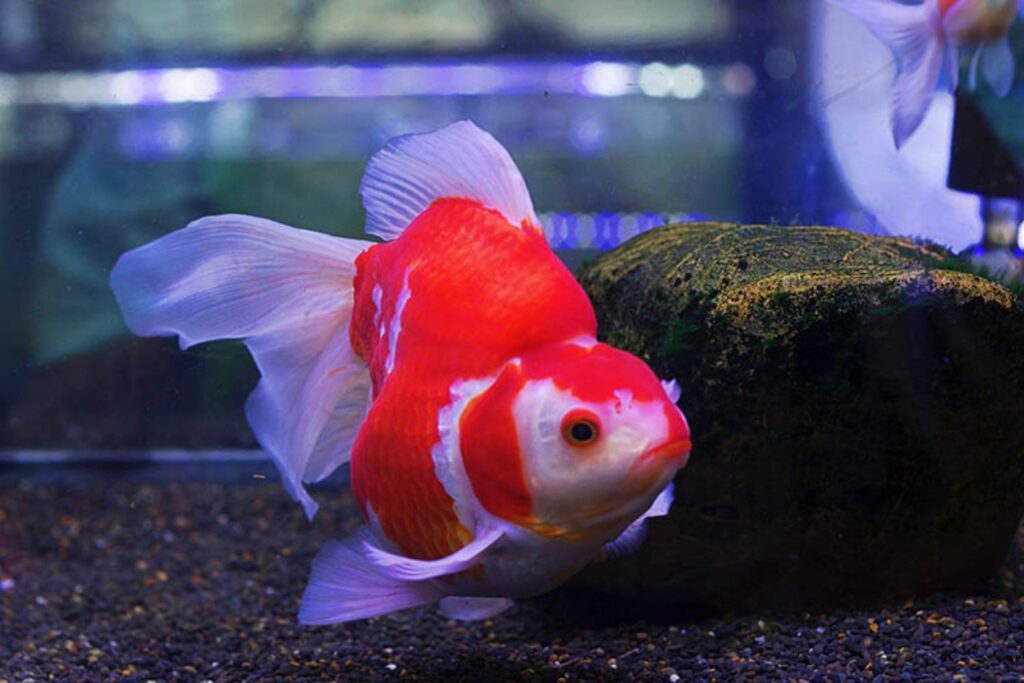
Tamasaba Goldfish, a rare variety from Japan, are characterized by their large, single-tail and robust body. They resemble the common goldfish in body shape but are larger and more stout, with a strong swimming style.
Ideal Habitat
Tamasabas are adaptable and can thrive both in tanks and outdoor ponds. In aquarium settings, they require ample space due to their size and active nature, with at least 30 gallons recommended for a single fish. In pond environments, they can exhibit more natural behaviors and are quite hardy across different climates.
Feeding Habits
Tamasaba Goldfish are omnivorous and enjoy a varied diet. This includes high-quality goldfish pellets or flakes, fresh vegetables, and occasional protein sources like brine shrimp or worms. They are vigorous eaters, so care should be taken to avoid overfeeding.
21. Shukin Goldfish
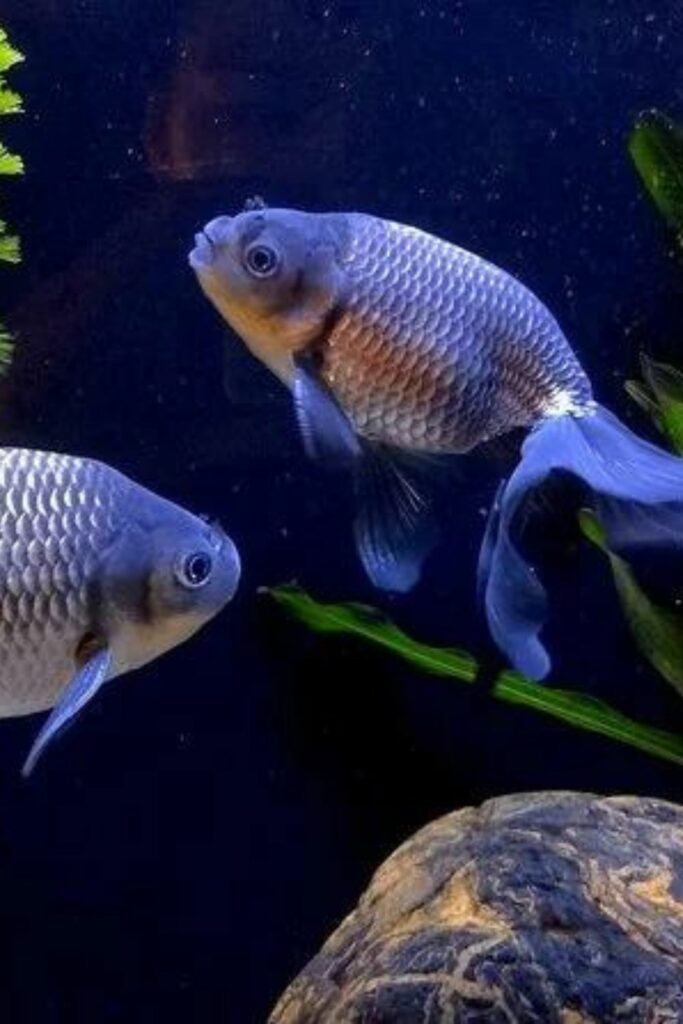
Shukin Goldfish are a rare and elegant breed, developed in Japan. They are characterized by a rounded, Ranchu-like body and a long, flowing tail similar to that of a Ryukin. Their unique blend of features from these two popular breeds makes them highly sought after by goldfish enthusiasts.
Tank Maintenance
Shukin Goldfish require a clean and stable environment to thrive. The tank should be spacious, with at least 30 gallons of water for a single Shukin, and equipped with efficient filtration to maintain water quality. Regular water changes are essential to remove waste and keep the water parameters stable.
Health Care Tips
Shukins, like many fancy goldfish breeds, are prone to swim bladder issues and other common goldfish diseases. A balanced diet, proper feeding practices, and a stress-free environment are key to preventing health problems. Regular monitoring for signs of illness and prompt treatment if needed are important for maintaining their health and well-being.
22. Egg-fish Goldfish
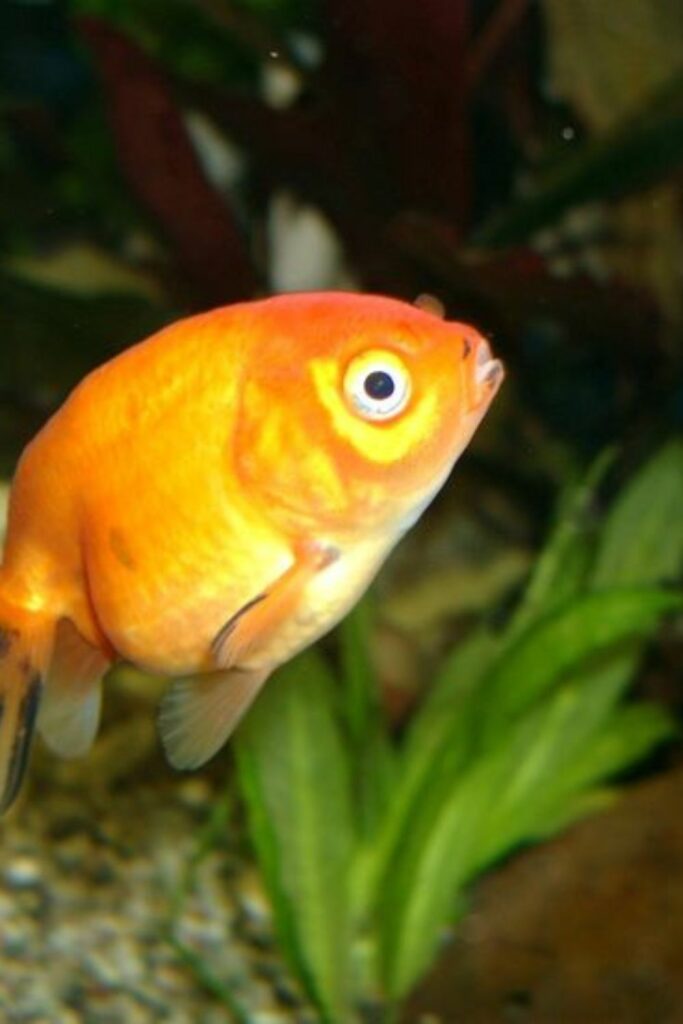
Egg-fish Goldfish are named for their distinctive egg-shaped body, lacking the dorsal fin typical of many other goldfish varieties. This unique shape gives them a smooth, rounded appearance. They come in a variety of colors and often have a chubby, compact look, making them a charming addition to any aquarium.
Suitable Aquarium Size
Due to their compact size and relatively calm swimming style, Egg-fish Goldfish do not require as large an aquarium as some other breeds. A tank of at least 20 gallons is recommended for one fish, with additional space if housing more than one. This allows enough room for comfortable movement and helps maintain water quality.
Breeding Behavior
Breeding Egg-fish Goldfish can be a rewarding experience. They typically spawn in the spring when water temperatures rise. Providing a breeding tank with fine-leaved plants or spawning mops gives them a place to lay their eggs. It’s important to remove the adults after spawning to prevent them from eating the eggs.
23. Phoenix Goldfish
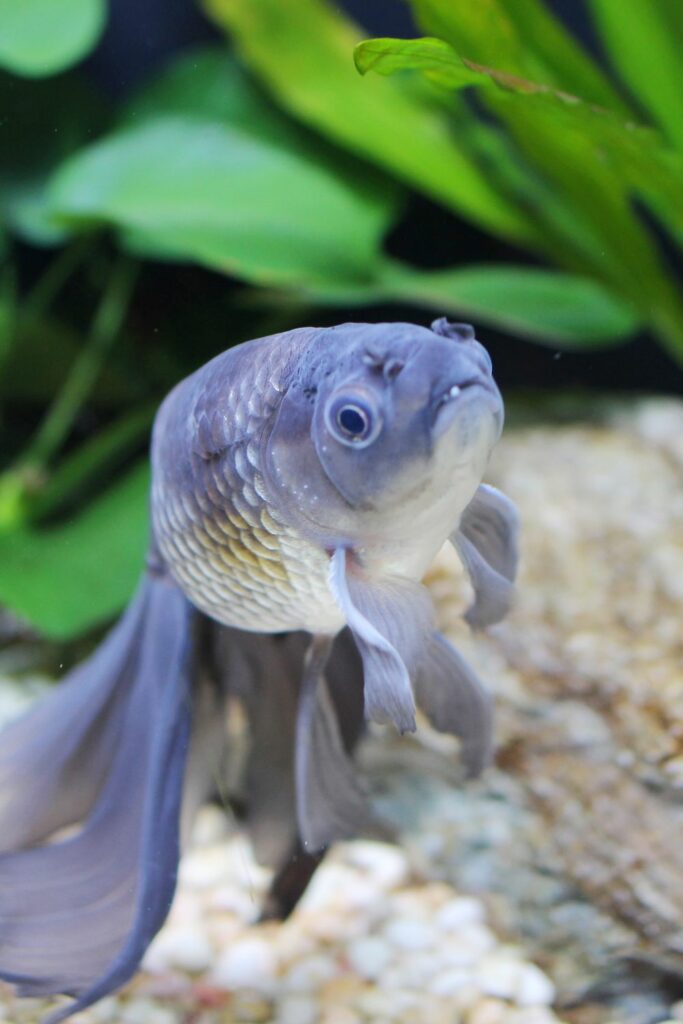
Phoenix Goldfish are prized for their long, flowing tail fins, which can be several times the length of their body. This impressive tail requires ample space to display its full beauty, making tank size and setup important. Care should be taken to prevent fin damage, which can occur in cramped conditions or with sharp tank decorations.
Nutrition Needs
A balanced diet is vital for the health and coloration of Phoenix Goldfish. They should be fed a variety of foods, including high-quality goldfish pellets, leafy greens, and protein sources like brine shrimp or daphnia. Feeding in small, frequent amounts is preferred to maintain water quality and prevent digestive issues.
Compatibility with Other Goldfish
Phoenix Goldfish are generally peaceful and can coexist with other non-aggressive goldfish breeds. Their long fins make them slower swimmers, so they are best housed with breeds that will not outcompete them for food or nip at their fins.
24. Izumo Nankin Goldfish
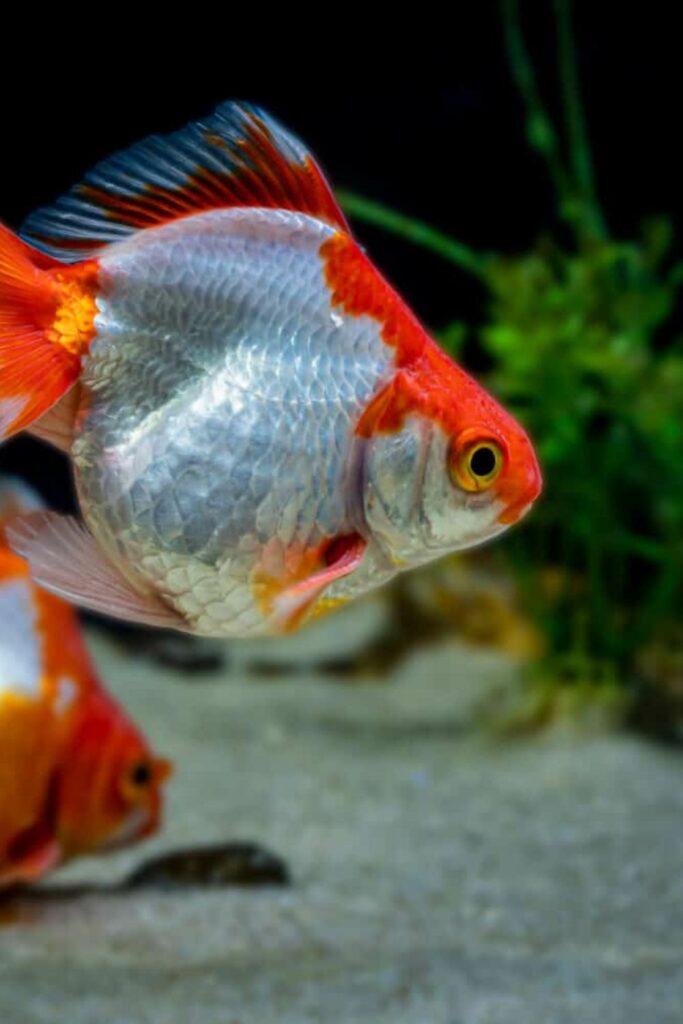
Izumo Nankin Goldfish are a rare and ancient breed from Japan, known for their small size, elegant body shape, and unique color pattern, typically vibrant red and white. They have a short, rounded body and a characteristic split caudal fin, making them a coveted breed among goldfish enthusiasts.
Special Care Instructions
Due to their rarity and specific breeding, Izumo Nankin Goldfish require careful attention to maintain their health and appearance. They thrive in a well-maintained tank with stable water conditions – a temperature range of 65 to 75 degrees Fahrenheit and a pH level between 6.5 and 7.5. They are sensitive to changes in water quality, so regular testing and maintenance are essential.
Breeding and Conservation
Breeding Izumo Nankin Goldfish contributes to the conservation of this rare breed. A dedicated breeding tank with optimal water conditions and nutrition is important.
Breeders should be knowledgeable about genetic traits and breeding practices to ensure the health and purity of the lineage. Due to their rarity, efforts to breed Izumo Nankin Goldfish play a crucial role in preserving this unique and historic goldfish variety.






